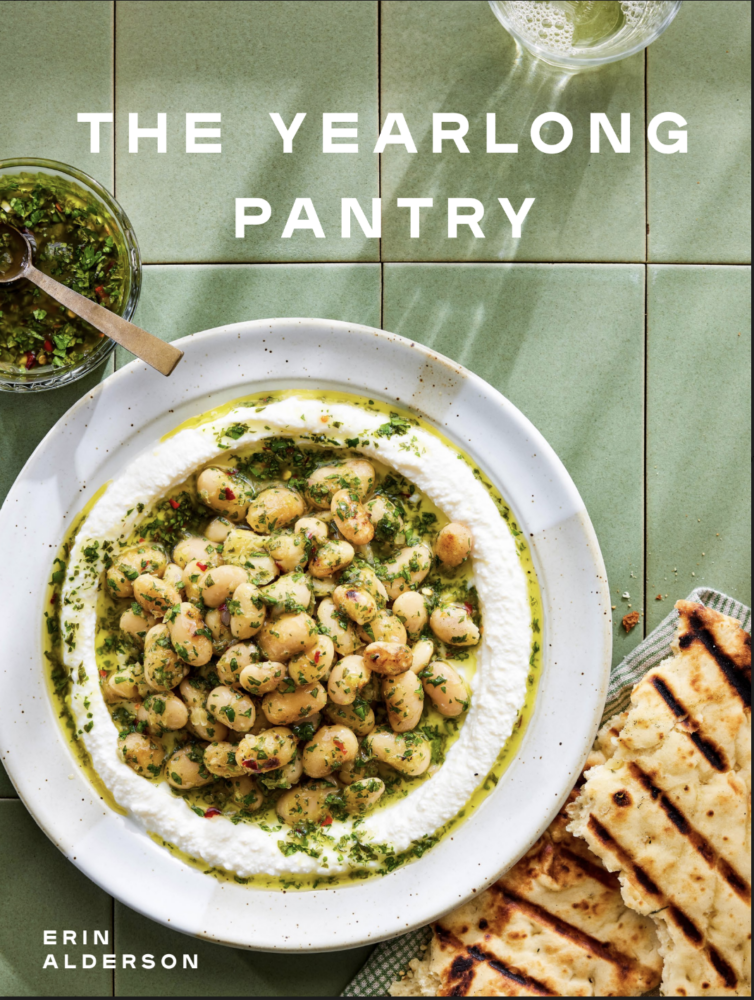

Opening a well-stocked pantry provides me with a particular kind of joy I cannot replicate in other parts of my life. Gazing upon a myriad of ingredients fills me with inspiration and excitement. These ingredients make filling meals with fresh produce possible, whether following a recipe or throwing a quick bite together. Once you stock a pantry, the possibilities or limitless.
Below are the ingredients I keep on hand or cycle through, depending on my current tastes and desires. For example, I always have a couple of jars of crushed tomatoes on hand but cycle through different types of cheeses. Stocking a pantry is quite individualistic, but hopefully, this list gives you a place to reference!
As a bonus, many of these categories are ones you can make from scratch, some more involved than others. Where applicable, I've linked to books and resources I've found helpful. While I know not everyone desires to make their own vinegar, I do, and I figure there might be a few others who share the same curiosity!

What follows is quite the dive spread out over many pages. If you'd like a handy and concise resource for all the information, I highly recommend preordering a copy of my upcoming book, The Yearlong Pantry!
Before diving into the ingredients, a quick note about cycling through items, whether weekly, monthly, or yearly. Very few ingredients are meant to stay fresh for a long time, and as such, it's helpful to think of even these ingredients as fresh. Vinegar, for example, will keep and hold flavor for years, while chiles are best within a year of harvest.
As you use these ingredients, you'll find a rhythm. For the yearly items, I'll aim to replace them during winter as the majority are harvested in the fall, specifically grains, legumes, chiles, nuts, and seeds. Some items, like certain ferments and canned items, are made during the applicable times of the year, such as canned tomatoes during summer or homemade miso in spring. All other items I purchase or make on an as-needed basis.
When I'm attempting to throw together a quick meal, I reach for broth. Soups, stews, beans, noodles, and pasta can all benefit from a solid broth base. While I try to keep store-bought broth stashed in the pantry, I often make large batches to freeze. Homemade broth allows me to control the flavor and use produce that might otherwise not have a purpose.
I like to freeze broths in large silicone ice cube trays and then transfer them into storage bags that are frozen for this purpose. Freezer-safe glass or cambro containers also work well; they just take up a bit more space. Just ensure the container you are using is freezer-safe!
Homemade Broths
Pantry Items
Beyond grains and legumes, my other not-so-secret obsession revolves around the items belonging to the capsicum genus, otherwise known as peppers/chiles. While we mostly know chiles as providing a varying level of heat, chiles bring a wide range of sweet, smoky, earthy, and fruity flavors. These flavors are often present as dried fruit, chocolate, citrus, floral, grass, and more (not unlike the flavors usually found in wine).
Most dried chiles we use today fall into five domesticated specifies, all belonging to the C. annum species. Stores such as Spice Trekkers, Oaktown Spice Shop, The Spice House, Diaspora Co, and Boonville Barn Collective. If you want to grow your own, I highly recommend looking through this website for seeds.
When choosing chiles, buy ones that have harvest information. Over time, chiles continue to lose moisture and flavor, leaving a bland chile that won't reconstitute. Ideally, use chiles within a year of harvest. Beyond time, look for chiles that match the flavor profiles you are looking for and within the range of Scoville heat units (shu) you desire. Many of the chiles below also come in powder and flakes which are also lovely and great for when you want something quick and easy to use.
If you want to learn how to use dried chiles, I recommend this guide from Serious Eats.
I adore cheese, but I rarely use it just to make something overly cheesy. Like many of the ingredients in my rotation, cheese plays a myriad of roles. Sometimes, it's flavor (think blue cheese), sometimes it's adding a level of umami goodness (parmesan), sometimes it's having a creamy texture (ricotta), or sometimes it's the star of the show (halloumi).
Given how I use cheese, I keep 2-3 cheeses throughout the week. I typically keep one solid melting cheese for things like pizza or grilled cheese, a frying cheese for a protein main, and a flavor-forward cheese for fun projects.
Some of the cheese below, such as ricotta or paneer, can easily be made at home. Would you like to try your hand at cheese making? I recommend Mastering Basic Cheesemaking by Gianaclis Caldell, Home Cheese Making by Ricki Carroll, and Artisan Cheese Making at Home by Mary Carlin.
While I gravitate towards dairy-based cheeses, the market for vegan-friendly cheese is vast and ever-expanding, with cheeses of all styles.
Look to see what your local grocery stores carry. If you're interested in making your own, books I recommend include The Art of Plant-Based Cheesemaking by Karen McAthy, This Cheese is Nuts! by Julie Piatt, and Vegan Cheese by Jules Aron.
One note: not all cheeses (a few on this list) are vegetarian-friendly, as they use rennet made from animals. If you're looking for vegetarian-friendly cheeses, look for ones that use 'vegetarian' or' microbial' rennet.
Fresh, no rind:
Fresh, suitable for frying
Surface Ripened (Soft or Mold) Cheese
Washed Rind + Semi-Soft Cheeses
Semi Firm and Firm, Pressed or Aged Cheese
Blue
As the title suggests, these items add a bit of crispiness to meals. They can be made at home or bought in stores.
As with cheese, I tend to stick with the dairy versions of these items. However, given the push for plant-based alternatives, most can be interchanged in recipes.
One of the categories I am most passionate about, most likely due to growing up in the 1990s when we vilified fats. Luckily for us, our bodies need fats; this category is a great way to make vegetarian meals feel well-rounded and fulfilling.
I segment fats into two general categories, similar to the marketing of olive oil: cooking and finishing. A couple of items I use interchangeably, but for the most part, fats play specific roles in my kitchen. Cooking fats tend to be mild in flavor and come with the ability to heat well. Finishing fats are better for low or no heat and are great finishing touches, especially when flavored with herbs, spices, and alliums.
Cooking and Finishing Fats
Cooking Fats
Finishing Fats
When people ask me why my food tastes so good, I often tell them I use items from this category. Fermented and pickled items add complex layers of salt and acid to dishes that a sprinkle of salt or a splash of vinegar can't quite achieve.
If you're interested in making some of these items at home, I recommend The Art of Fermentation by Sandor Katz, Koji Alchemy by Jeremy Umansky and Rich Shih, Wildcrafted Fermentation by Pascal Baudar, The Noma Guide to Fermentation by René Redzepi, and The Book of Miso by William Shurtleff and Akiko Aoyogi. For cultures, I highly recommend Gem Cultures.
Whether stashed in the pantry or freezer, I always have items on hand that can help me put meals together quickly.
My pantry of grains is extensive and exciting! You can dive into individual grains in the grain section.
On par with my love of grains is my obsession with legumes. You can explore the world of legumes in the legume section.
The third leg of my pantry trifecta: nuts and seeds! You can learn more about these in the Nuts + Seeds section.
Beyond legumes and cheeses, I have a handful of protein options I keep on hand (and also make). These are the items I rotate weekly, depending on the meals I'm making. If you're interested in trying your hand at making these, I recommend Asian Tofu by Andrea Nguyen, Miso, Tempeh, and Natto & Other Tasty Ferments by Kirsten Shockey. For Seitan, these instructions are good for a wheat-gluten-based option or these instructions if starting from flour.
It's one of the few categories that needs little explaining!
Every pantry would be complete with a solid spice collection. Just remember to cycle through your spices, as they lose flavor over time. Fresh and aromatic spices can make all the difference in your food!
I typically keep whole spices on hand and process as needed to maintain as much flavor as I can. However, I recognize that's only practical for some or some meals. Purchase and use pre-ground spices with no remorse!
I typically order everyday spices from Diaspora Co, Burlap and Barrel, or Oaktown Spice Shop. If I'm looking for something specific to a region or spices I can't find elsewhere, I turn to Spice Trekkers.
Whole
These sit alongside my baking ingredients, which I use for thickening, coatings, and more.
It's an extensive list, but every sweetener has a job, whether it's a baseline sweetness, a finishing flare, a binding agent, or a nice bit of flavor. Luckily, sweeteners are one of the more shelf-stable items in the pantry.
I find it impossible to convey my love for tomato products. While I love a good summer tomato like the next person, canned tomatoes are a lifeline throughout the year. They form the basis for soups, stews, paellas, and pizzas.
Canned Tomatoes
Tomato-Based Products
Finally, I consider vinegar to be one of the greatest magic items in cooking. I keep nearly all these vinegars on hand at all times because they all play a role in my cooking. Vinegars are used in small amounts to build flavor, large amounts for pickles, and everywhere in between. Some of these vinegars are bold in flavor, while others are more mild, but they are not to be discounted.
If you're as interested as I was, you can also make vinegar. I recommend reading through Vinegar Revival by Harry Rosenblum, Acid Trip by Michael Harlan Turkell, Homebrewed Vinegar by Kirsten Shockey, and the Artisanal Vinegar Maker's Handbook by Bettina Malle and Helge Schmickl (a great one for the chemistry of vinegar). I also recommend picking up a starter from Supreme Vinegar (and reading through their resources)!

